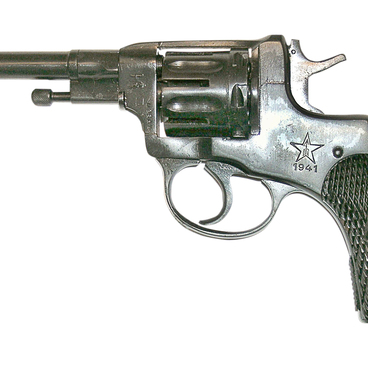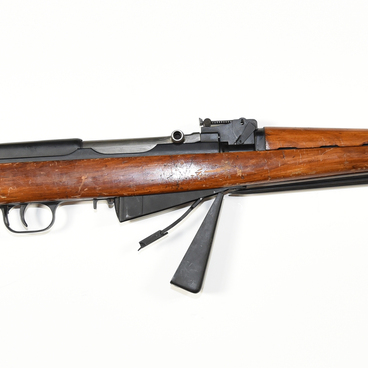The self-loading carbine, created by guns designer Sergey Simonov at the end of the Great Patriotic War, marked a new era in the history of Russian firearms. By that time, Simonov had already designed an automatic rifle chambered for a powerful 7.62×54R mm cartridge and a self-loading 14.5 mm PTRS anti-tank rifle.
The prototype of the carbine was developed by Simonov in 1940–1941, but the launch of its production was postponed due to the evacuation of plants. Simonov based his further work on his old designs. Besides, he took into account the climate and a wide range of air temperatures and humidity on different fronts, dirt and dust, the peculiarities of enemy weapon systems and cartridges.
Prototypes of the Simonov self-loading carbine chambered for an intermediate 7.62 mm cartridge were ready by the end of 1944. The new rifle had a single stock and a non-removable folding bayonet. It did not have a muzzle brake to reduce the recoil, and it was equipped with a removable gas chamber to discharge powder gases. The barrel length of 520 millimeters ensured good bullet acceleration and high hitting accuracy.
The SKS-45 carbine was loaded from a magazine with 10 rounds. To do this, it was necessary to put the bolt on delay and lower the clip from above into the non-removable magazine. Since the SKS-45 bolt group consisted of only a few components, it could be easily disassembled and cleaned. Even a civilian could learn to use this carbine in two hours.
A small batch of SKS-45 was tested by active units of the 1st Belorussian Front in early 1945. These carbines were also supplied to the “Vystrel” higher officer courses which provided retraining to the command staff of the army ground forces. The SKS-45 received general recognition for its simple design, low weight and effectiveness in combat. All rifle components were finalized after the war. The SKS-45 was put into service only in 1949.
The same year, the Tula Arms Plant launched mass production of SKS-45, and in 1952, the Izhevsk Mechanical Plant also started manufacturing these carbines. By 1956, 2,685,900 carbines were produced, after which their production stopped, but they remained in service. In particular, the air force, marines, strategic missile forces, and infantry used the SKS-45 until the mid-1980s, when SKS-45 was finally replaced by the AK-74 assault rifle.
The prototype of the carbine was developed by Simonov in 1940–1941, but the launch of its production was postponed due to the evacuation of plants. Simonov based his further work on his old designs. Besides, he took into account the climate and a wide range of air temperatures and humidity on different fronts, dirt and dust, the peculiarities of enemy weapon systems and cartridges.
Prototypes of the Simonov self-loading carbine chambered for an intermediate 7.62 mm cartridge were ready by the end of 1944. The new rifle had a single stock and a non-removable folding bayonet. It did not have a muzzle brake to reduce the recoil, and it was equipped with a removable gas chamber to discharge powder gases. The barrel length of 520 millimeters ensured good bullet acceleration and high hitting accuracy.
The SKS-45 carbine was loaded from a magazine with 10 rounds. To do this, it was necessary to put the bolt on delay and lower the clip from above into the non-removable magazine. Since the SKS-45 bolt group consisted of only a few components, it could be easily disassembled and cleaned. Even a civilian could learn to use this carbine in two hours.
A small batch of SKS-45 was tested by active units of the 1st Belorussian Front in early 1945. These carbines were also supplied to the “Vystrel” higher officer courses which provided retraining to the command staff of the army ground forces. The SKS-45 received general recognition for its simple design, low weight and effectiveness in combat. All rifle components were finalized after the war. The SKS-45 was put into service only in 1949.
The same year, the Tula Arms Plant launched mass production of SKS-45, and in 1952, the Izhevsk Mechanical Plant also started manufacturing these carbines. By 1956, 2,685,900 carbines were produced, after which their production stopped, but they remained in service. In particular, the air force, marines, strategic missile forces, and infantry used the SKS-45 until the mid-1980s, when SKS-45 was finally replaced by the AK-74 assault rifle.

